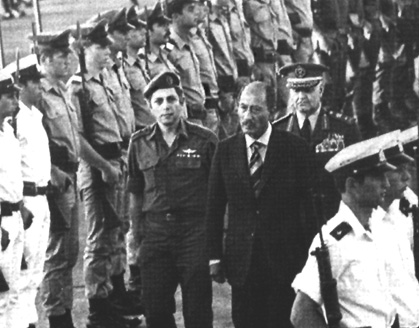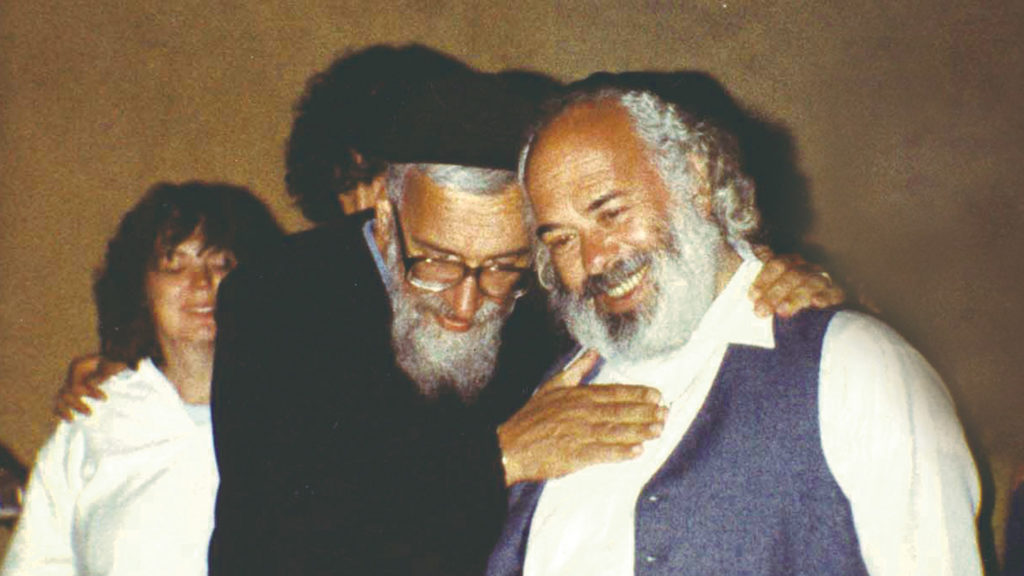Sadat in Jerusalem: Behind the Scenes
On November 9, 1977 Egyptian President Anwar Sadat surprised the Egyptian People’s Assembly and all those in attendance (including, as it happened, PLO Chairman Yasser Arafat) by setting aside his prepared text and declaring that he was “ready to travel to the ends of the earth” to protect Egyptian lives and that “Israel will be surprised to hear me say that I am willing to go to their parliament, the Knesset itself.” Ten days later, on November 19, Sadat landed in Israel for his historic two-day visit.
Sixteen months before Sadat’s visit, I had returned to active duty with the IDF after many years immersed in the study and teaching of Arabic literature at The Hebrew University. At the request of then-Minister of Defense Shimon Peres I became the head of the Department of Arab Affairs for the military government of Judea and Samaria.
At that time, Palestinian public life was dominated by the October 1974 resolution of the Arab Summit in Rabat, according to which the PLO was the sole legitimate representative of the Palestinian people everywhere. We at the Department of Arab Affairs in Judea and Samaria were keenly aware of the momentous implications of this decision, but the significance was less clear to Israel’s decision makers at the time. Perhaps their failure was the innate tendency of self-proclaimed pragmatists to underestimate the importance of programmatic, ideological declarations. Or maybe it stemmed from the simple fact that so many Arab summit resolutions were never implemented.
In any case, these officials failed to reckon with the way in which the Rabat resolution confirmed and consolidated the PLO’s standing in the Territories. Unsurprisingly, the PLO fiercely enforced compliance with this resolution from its headquarters in Beirut, threatening to kill any Palestinian who dared to defy it. After Sadat’s speech, the Arab press in the Territories broadcast the PLO’s fierce opposition to his impending visit. Yet we at the Department of Arab Affairs noticed that, despite the general impression that the entire Palestinian public in the Territories was unanimously opposed to the Sadat initiative, in reality there were many who hoped for political change and were willing to welcome his visit.

On Wednesday, November 16, 1977, I was given instructions from then-Minister of Foreign Affairs Moshe Dayan to invite several Palestinian figures from Jerusalem and the West Bank to welcome Sadat at Ben-Gurion Airport. The list I was given included a number of pro-PLO mayors who had been elected about 18 months previously. I immediately told the coordinator of government activities in the Territories who had relayed Dayan’s order to me that every single person on Dayan’s list would refuse the invitation. He replied that Dayan believed, to the contrary, that they would accept it. I should add here that Dayan was held by his many admirers to possess uncanny insight into the so-called “Arab mind.” I did as I was told, and invited the figures on Dayan’s list, including Nablus Mayor Bassam Shak’a, Ramallah Mayor Karim Khalaf, and Hebron Mayor Fahd Qawasmeh. They all refused.
I notified the coordinator, who soon got back to me and said, “The Foreign Minister now asks that you prepare a list of people you believe will accept the invitation.” In fact, I already had the list ready, because I had gone through a similar experience a few months earlier, when Dayan had held a reception for U.S. Secretary of State Cyrus Vance. Then, too, Dayan had asked me to invite a number of people from Judea and Samaria, including pro-PLO mayors, dismissing my assessment that they would not come. When they had, in fact, turned down the invitation, I was urgently asked to find alternative candidates who would accept it. I had done so, and several distinguished Palestinians attended the reception at Dayan’s residence.
In both cases, when Dayan acquiesced to a list of invitees who might actually come, he added one telling restriction: I was not to include Aziz Shehadeh, a prominent lawyer from Ramallah who was known for his opposition to the PLO and his willingness to negotiate with Israel. (He was later assassinated, on December 2, 1985.) Dayan’s caveat was symptomatic of his distaste for moderate Palestinians. He made it publicly known that he regarded Palestinian terrorism as a “natural” response to their condition and consequently did not really take Palestinians who openly rejected terrorism seriously—even though it required a great deal of personal courage (and strong backing from one’s clan) to publicly deviate from the official PLO line.
The question of which Palestinian figures should be invited to welcome Secretary Vance, or who should meet President Sadat at the airport, may appear to involve trivial matters of protocol—and, in a sense, they did. Yet this affair highlighted the substantial difference between two approaches to relations with the Palestinians: that of Dayan—the man who had determined Israel’s policy in the Territories since the 1967 war—and the very different approach in which I believed. The principle that guided me in all my work as advisor on Arab affairs, and later as head of the Civil Administration in the West Bank, was that Israel had to encourage and protect those Palestinians who favored coexistence, whether they were pro-Jordan or proponents of Palestinian independence.
It so happened that I had yet another involvement in Sadat’s visit. On the same Wednesday, November 16, 1977, a few hours after I received the instruction to prepare a list of Palestinians for Sadat’s reception, I received a call from Prime Minister Begin’s military secretary, Brigadier General Ephraim Poran, who informed me that the government had chosen me to be the military aide-de-camp for the visiting president. Accordingly, I was asked to join the committee coordinating the visit, which was chaired by Poran himself and included high-ranking representatives of the relevant government ministries, among them the deputy chief of the Shin Bet (the General Security Service).

(Photo by Miki Tzarfati, courtesy of the Government Press Office, Israel.)
One of the most sensitive issues facing the committee was the problem of Sadat’s safety, in particular during his prayer at the Al-Aqsa Mosque on Sunday, before his speech in the Knesset. When the committee met, Poran told us that, following the recommendation of the security services and the police, it had been decided to bar all worshippers from the Al-Aqsa compound during Sadat’s visit, except for his entourage and the heads of the Muslim Waqf, which administers the mosque, together with a small number of correspondents and TV teams. Our principal concern was, of course, that the PLO, or conceivably someone else, might make an attempt on President Sadat’s life. If they were to do so, his visit to the mosque was their best opportunity. There was even a terrible precedent: In July 1951, King Abdullah I of Jordan (the great-grandfather of the present king of Jordan) had been assassinated in the Al-Aqsa Mosque by a Palestinian gunman. To compound matters, Sunday was Eid Al-Adha, the most important holiday of the Muslim year. Although I understood the security considerations, barring worshippers from the Al-Aqsa compound struck me as deeply misguided. The other committee members did not at first grasp what it would mean to let Sadat be seen on TV screens across the Arab world praying at the mosque in isolation. Such a scene would in itself be a victory for those who opposed the visit.
I pointed out to my fellow committee members that one measure of the success of this event would be how it was covered in the media. It was extremely important, I said, that the images of Sadat’s prayer at Al-Aqsa, just before his visit to the Knesset, showed him surrounded and applauded by many Palestinian Muslim worshippers. “So what do you propose, Menahem?” Poran asked jokingly, “Do you think you can train an Israeli infantry unit to pray the Muslim prayer, and we will dress them up in kaffiyehs?” “No,” I answered, “I am talking about real Arab Muslim worshipers. According to our inquiries in the last few days, there are thousands of Palestinians who would be willing to come and pray with Sadat.” My fellow committee members were persuaded by my argument, but the big question was what the heads of the security apparatuses would say. Both the representative of the police and the deputy chief of the Shin Bet said that, in a matter of such sensitivity, the final word would have to come from the heads of their respective organizations, Police Chief Haim Tavori and Security Agency Director Avraham Ahituv.
The decision was postponed until Friday morning. In the meantime, my staff in the Department of Arab Affairs and I continued to appraise Palestinian public opinion. Despite the threats and the incitement of the PLO, we believed that there were indeed thousands who would come to pray with Sadat if given the chance. On Friday morning, I spoke with Tavori and Ahituv, and they agreed to let Arab worshippers attend prayers at the Al-Aqsa Mosque that Sunday, as long as everyone entering the mosque was searched and the number of worshippers was limited to 1,500 people. Elated, I immediately told my deputy at the Department of Arab Affairs Yigal Carmon to notify a number of leading figures in the Hebron and Bethlehem districts that they would be able to come with their men and pray with Sadat.
On Saturday night, when Sadat landed at the airport and approached the reception line, a number of Palestinian figures from the West Bank were waiting to shake his hand, among them the mayor of Bethlehem, Elias Freij; the mayor of Beit Jala, Farah Al-A’raj; Mustafa Dudeen from the Hebron area; two leaders from Nablus; and Sheikh Muhammad Ali Al-Ja’bari, the former mayor of Hebron, who was known for his good relations with the Jordanian king. The next day, when President Sadat and his entourage arrived at the Al-Aqsa Mosque, it was full of Muslim worshipers who had arrived early in the morning in busses and trucks. When he entered the compound, a cheer went up: “Long live the hero of peace, we shall sacrifice our blood and life for you, O Sadat.” Sadat’s face lit up and his companions smiled in satisfaction as press and TV cameramen captured the moment.
The next day, Sadat met with several of the Palestinian figures who had welcomed him at the airport, as well as Anwar Al-Khatib from Jerusalem and Hikmat Al-Masri from Nablus. Upon his return to Egypt, he declared: “In Jerusalem I met the real Palestinians.” It was, ironically, precisely the reverse of Moshe Dayan’s position.
Of course, this is all something like ancient history in Israeli-Palestinian relations by now. Over the last three-plus decades, we have seen the Oslo Accords and recurrent rounds of negotiations that have led nowhere. All the more reason, then, to recall those brave Palestinians who 38 years ago defied the PLO and welcomed Sadat at Ben-Gurion Airport.
Suggested Reading
The Shtetl Trap
How should we think about the Eastern European market town? Did the shtetl ever have a golden age?

All-American, Post-Everything
Shaul Magid argues that Zalman Schachter-Shalomi is the Rebbe for post-ethnic America. But is cosmotheism a good idea?

New Beats for Old Brooklyn
Andy Statman started out as an unlikely prodigy: a New York Jewish kid playing bluegrass on the mandolin.
Politics and Anti-Politics
Michael Walzer asks new questions of the biblical text, the same sorts of questions we often ask of Locke or Voltaire.
Comments
You must log in to comment Log In